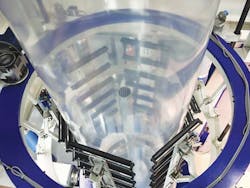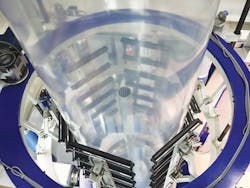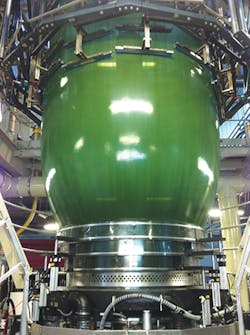Retrofitting flourishes for blown film systems
Retrofitting and rebuilding projects use new technology to modernize and upgrade older technology, thus postponing or eliminating the need to buy new equipment. It doesn't get the spotlight, but retrofitting is continuously going on in the background. To give you a better feel for how this is happening, PMM asked Davis-Standard LLC, Pawcatuck, Conn., and Gloucester Engineering Co. Inc., Gloucester, Mass., for specific examples of retrofitting blown film systems, a busy area for retrofitting.
Gloucester President Carl Johnson and Bill Hellmuth, product group director, blown film, told PMM how the ongoing retrofitting of a blown film line belonging to a processor in the Midwest has developed. The line being upgraded is a Gloucester 2.3-meter-wide, seven-layer, high-barrier system installed in 2003. The processor was looking for someone to help fix a list of issues that included wrinkles, leaks in another OEM's adapters and marks in the film made by rollers in the bubble cage.
The company started to shop around for solutions with an eye for the best return on investment (ROI). It contacted Gloucester, the line's original supplier, after taking quotes from other extrusion companies, still looking for another option. Gloucester offered a solution that, first of all, didn't involve spending dollars replacing equipment that still functioned. Its general plan was to retrofit only what needed upgrading and keep what worked. Gloucester also said it would make the process manageable for the processor as it does for all its retrofits: The retrofit would be done on the processor's schedule and in phases. Keeping a line running as long as possible before taking it down for maintenance is a priority that was incorporated into Gloucester's quote.
The processor originally wanted to tackle everything in a single step. Based on its experiences with many retrofits, Gloucester favors multiple steps. One reason is that sometimes a change in phase one actually can eliminate the need for a phase two or three. Also, changing many things at once can cause problems down the line. Doing a portion at a time helps maintain control over the full system. For Gloucester, changes on the second step should be made only once the first wave of changes is performing well. The line's owner agreed to Gloucester's two-part quote.
Gloucester says it split the full retrofit into two phases because the customer desired a handful of improvements, and the results of each needed to be visible and quantifiable, something that's easier to accomplish in phases. Phase one revolved around three issues: increasing output rates, improving film quality and eliminating wrinkles. It also included some mechanical issues that affected those three performance issues. In phase two, Gloucester will address the customer's request to further improve bubble cooling. A phase-two proposal that will include line enhancements from Gloucester and its acquisition, Pearl Technologies Inc., Savannah, N.Y., is well underway.
Before proposing anything, Gloucester says it likes to see the issues firsthand. Knowing the root causes helps determine the right approach. Gloucester specialists visit the customer's facility to perform a line audit, talk with management and operators and exchange information. A project manager who will oversee every aspect of the job is appointed. A proposal is then drafted and tweaked until agreement is reached.
Gloucester stresses the need for constant communication. That, Hellmuth and Johnson say, is important to making sure the retrofit work doesn't interfere with production and that the installation happens within the customer's time frame. And when the job is done, Gloucester stays in contact to make sure everything continues to run smoothly. Gloucester offers lifetime support, available whenever the customer needs it.
Phase one of the retrofit eliminated wrinkles after changing the cage and also helped with backside treat issues. Phase one also reduced gels and scrap, restored the original output rate, enhanced blow-up ratio capability, and improved bubble stability, film quality blender accuracy and melt control.
Gloucester says the customer is very pleased with the retrofitted line's performance following phase one. At a minimum, the customer wanted to have its old line returned to its original standards and productivity. Gloucester's plan not only succeeded in helping the customer obtain that, but also exceeded the customer's expectations. The line performs better than when new.
Johnson and Hellmuth say most of their customers do not share profitability information so it's difficult to state exact ROI. What is known is that the processor had an immediate 12 to 15 percent increase in output. The third-party adapters and screen changers were replaced and the leaks are gone. The processor now can run two-up without wrinkles and not get returns for backside treat. Feed screw changes allowed the company to effectively adapt to today's higher performing film structures and greatly improved its overall film quality. Hellmuth and Johnson say those things taken together sound like pretty good payback.
analysis of constraintson system makes sense
PMM also spoke with Tom Kennedy, VP, blown film, at Davis-Standard, who shared some of his company's retrofitting experience. The examples he gave emphasized using leading-edge technology and taking a systems approach.
Kennedy described a retrofit for a Davis-Standard customer in Europe that showed how the systems approach and the latest technology can combine to produce an impressive benefit. The processor wanted more output from an existing blown film line with an 800mm die. Davis-Standard went to the processor with its new UpJet air ring system, explained the potential, and the processor decided to purchase it. The result was an increase in output of over 25 percent, going from about 1,540 pounds per hour to about 1,980 pounds per hour.
There is a catch. The only thing that changed on that line was the air ring, but Kennedy emphasizes that the great output increase was possible only because the line had adequate extrusion capacity and tower height to take advantage of the cooling capacity of the UpJet air ring.
"Everything was there to realize what the improvement by the air ring could provide," Kennedy says. That's not always the case, he adds. A line could be extruder-limited or tower-height-limited, but this one was ready.
"The payback on this is huge. This is about 3.5 million pounds of additional annual capacity from a relatively inexpensive investment."
He says a processor may have preconceived ideas about a retrofit, for example thinking it could benefit by upgrading just one key element of the line, perhaps with a high-performance air ring. Kennedy says an analysis to see what parts of the line are constrained is needed. "Usually you're cooling-limited, but if your air ring and your die are designed to run at a high pressure with the existing extruder rate, you're not going to be able to fix that with a new air ring alone. You may need a new die or a new extruder, or to change the screw."
Speaking of screws, Kennedy says Davis-Standard has expanded its DSP line of screws in the low-work range. It now has four: low work, very low work, super low work and ultra-low work. They can achieve higher output rates in a given extruder, though it should be noted that they don't mix colors as well as a medium-work screw. On the other hand, they require a lot less energy. In fact, a Davis-Standard customer recently justified buying one of the new screw designs solely on energy savings, then found that it reduced the melt temperature so much that the company was able to achieve good increases in its output rate. The bubble was more stable exiting the die at a lower temperature.
Another Davis-Standard customer had a 3½-inch extruder using LLDPE with a standard screw that could run 450 to 500 pounds per hour. With a low-work screw of the same size, the extruder could run as much as 900 pounds per hour. But, says Kennedy, "The nip and downstream equipment may not be able to keep up with what the die, extruder and air ring can do. You have to do a constraint analysis to identify where all the constraint points are. You then must ask yourself, 'How much must I invest and what will my return be?' "
For instance, a manufacturer that invests upstream might not realize all the benefits, if the company's nip is limited to 300 feet per minute. However, it may take only a new motor and gearbox to make the nip capable of the new rate.
It pays to investigate alternatives. Kennedy notes that some processors are adding extruders to go from monolayer to three layers and gain a higher output rate. "That still costs less than installing a new winder, nip and a new tower to gain a similar output increase, and you still get the additional sales dollars," he says. Also, that kind of retrofit is not only to gain more output. Going to a three-layer line also gives the processor more flexibility in formulations, which can help cut resin consumption and costs and allow the processor to take advantage of price fluctuations.
Kennedy says, "Most of the lines we are retrofitting are for polyethylene types of products, such as heavy-duty sacks, shrink films, can liners, construction film and so on. Barrier is different. We're not seeing a lot of people trying to upgrade a three-layer to a seven- or nine-layer line." One reason is because the extruders they have on the three-layer line are big and therefore would not be useful on a line with more layers. Those generally have smaller extruders and, obviously, more of them. He says the barrier lines going in are either complete new lines, or the hot section—meaning the extruder, die and air ring—is being upgraded. The downstream equipment may be saved, including the tower, collapsing frames, calibration and winders.
According to Kennedy, "Going from three to seven layers means you are changing markets, so you no longer have to justify the investment based on your three-layer business." It's a different proposition, not an upgrade but rather a capital investment for a new business. The products will sell at a higher price, but the investment will be higher too, as much as double the previous machinery cost. Materials like barrier resins cost more as well.
Kennedy says, "Our customers want to spend as little as possible to get the right functionality, and the discussion we have with them is about how to do that. How much control and how much precision do they need." Retrofitting can be a great alternative to investing in a new line, but the constraints throughout the blown film system must be considered to be sure the system can get the most out of the retrofitted upgrade.
Rob Neilley, senior correspondent
Contact:
Davis-Standard LLC, 860-599-1010, www.davis-standard.comGloucester Engineering Co. Inc., 978-281-1800, www.gloucesterengineering.com


